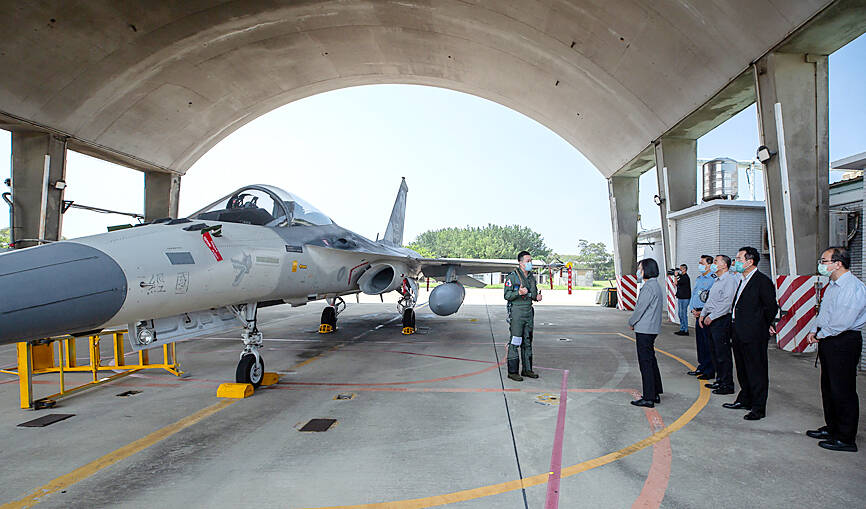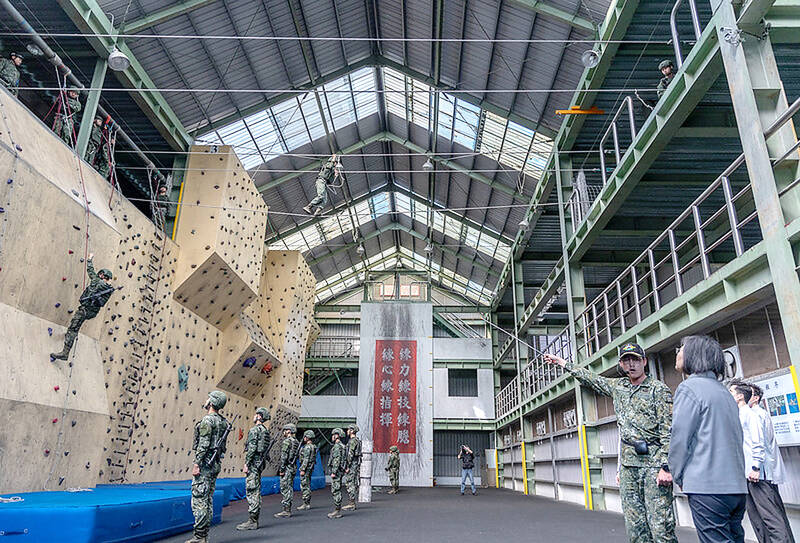The US is to sell Taiwan four sets of Norwegian Advanced Surface-to-Air Missile Systems (NASAMS), which can be integrated with systems Taiwan already uses, including the domestically developed Tien Chien II (Sky Sword) missile system, a source said yesterday.
The NASAMS can also be integrated with the US-made Avenger vehicle-launched air-defense missile system, which Taiwan also uses, through the use of a Link 16 military data link, the source said.
The NASAMS would be used to defend key areas, including military airports and government sites in Taipei, the source said.

Photo courtesy of the Presidential Office
Whether Taiwan would acquire the NASAMS through the US$2 billion in direct loans for military purposes stipulated in the Omnibus Consolidated Appropriations Act signed by US President Joe Biden last year, or the US$10 billion of grants over five years stipulated in the US’ National Defense Authorization Act for Fiscal Year 2023, remained unclear, the source said.
However, the NASAMS are expected to be delivered next year, they said.
“NASAMS combines the MPQ-64 Sentinel radar, compatibility with multiple types of short and medium-range air defense missiles, and the Link 16 military tactical data link network used by NATO,” the source said. “It is a powerful ground-to-air defense system that can defend against aircraft up to 50km away.”

Photo courtesy of the Presidential Office
Missiles compatible with NASAMS include the AIM-120 Advanced Medium-Range Air-to-Air Missile (AMRAAM), the AMRAAM Extended Range missile, the short-range AIM-9X Block II Sidewinder missile and the German-made IRIS-T short-range anti-aircraft missile, among others, the source said.
“The flexibility to use Sidewinders is a key advantage of the NASAMS, as we have seen in Ukraine. When a runway is damaged and planes cannot take off, the Sidewinders can be taken off the planes and loaded into the NASAMS,” the source said.
The acquisition of NASAMS, a laser-based drone defense system produced in the US and Norway, the AGM-158C Long Range Anti-Ship Missile and other types of precision ammunition promised to Taiwan by the US would greatly bolster Taiwan’s defensive capabilities, Institute of National Defense and Security Research fellow Su Tzu-yun (蘇紫雲) previously said in an interview.
Separately yesterday, President Tsai Ing-wen (蔡英文) thanked fighter jet pilots who scrambled against China’s air force during its drills around Taiwan proper and pledged to further bolster the armed forces.
China began the exercises, including simulated precision strikes with bombers and missiles, on Saturday last week, after Tsai returned from Los Angeles, where she met US House of Representatives Speaker Kevin McCarthy.
During a meeting in Taichung with pilots who are frequently stationed at a frontline air base in Penghu County’s Magong City (馬公), Tsai thanked them for their hard work and for sticking to their posts at all times.
“I want to tell everyone: As long as we are united, we can reassure the country’s people and let the world see our determination to protect the nation,” she said in a video clip provided by the Presidential Office.
Tsai added that the Taiwan-made Ching-kuo Indigenous Defense Fighters (IDF), which entered service in 1997, had been upgraded to more advanced versions.
“In the future, we will continue to upgrade software and hardware facilities, and improve personnel training,” she said.
Tsai’s office showed images of her talking to pilots dressed in flight uniforms and being given a briefing in front of an IDF parked in a hangar.
China’s three-day drills formally ended on Monday, but Taiwan has reported continued Chinese activity, although on a reduced scale.
Yesterday morning, the Ministry of National Defense said it had not spotted any Chinese military aircraft crossing the median line of the Taiwan Strait in 24 hours.
In its regular morning report on Chinese military activities, the ministry said it had detected four Chinese military aircraft and eight Chinese warships around Taiwan.

The US government has signed defense cooperation agreements with Japan and the Philippines to boost the deterrence capabilities of countries in the first island chain, a report by the National Security Bureau (NSB) showed. The main countries on the first island chain include the two nations and Taiwan. The bureau is to present the report at a meeting of the legislature’s Foreign Affairs and National Defense Committee tomorrow. The US military has deployed Typhon missile systems to Japan’s Yamaguchi Prefecture and Zambales province in the Philippines during their joint military exercises. It has also installed NMESIS anti-ship systems in Japan’s Okinawa

‘WIN-WIN’: The Philippines, and central and eastern European countries are important potential drone cooperation partners, Minister of Foreign Affairs Lin Chia-lung said Minister of Foreign Affairs Lin Chia-lung (林佳龍) in an interview published yesterday confirmed that there are joint ventures between Taiwan and Poland in the drone industry. Lin made the remark in an exclusive interview with the Chinese-language Liberty Times (the Taipei Times’ sister paper). The government-backed Taiwan Excellence Drone International Business Opportunities Alliance and the Polish Chamber of Unmanned Systems on Wednesday last week signed a memorandum of understanding in Poland to develop a “non-China” supply chain for drones and work together on key technologies. Asked if Taiwan prioritized Poland among central and eastern European countries in drone collaboration, Lin

Renewed border fighting between Thailand and Cambodia showed no signs of abating yesterday, leaving hundreds of thousands of displaced people in both countries living in strained conditions as more flooded into temporary shelters. Reporters on the Thai side of the border heard sounds of outgoing, indirect fire yesterday. About 400,000 people have been evacuated from affected areas in Thailand and about 700 schools closed while fighting was ongoing in four border provinces, said Thai Rear Admiral Surasant Kongsiri, a spokesman for the military. Cambodia evacuated more than 127,000 villagers and closed hundreds of schools, the Thai Ministry of Defense said. Thailand’s military announced that

CABINET APPROVAL: People seeking assisted reproduction must be assessed to determine whether they would be adequate parents, the planned changes say Proposed amendments to the Assisted Reproduction Act (人工生殖法) advanced yesterday by the Executive Yuan would grant married lesbian couples and single women access to legal assisted reproductive services. The proposed revisions are “based on the fundamental principle of respecting women’s reproductive autonomy,” Cabinet spokesperson Michelle Lee (李慧芝) quoted Vice Premier Cheng Li-chiun (鄭麗君), who presided over a Cabinet meeting earlier yesterday, as saying at the briefing. The draft amendment would be submitted to the legislature for review. The Ministry of Health and Welfare, which proposed the amendments, said that experts on children’s rights, gender equality, law and medicine attended cross-disciplinary meetings, adding that